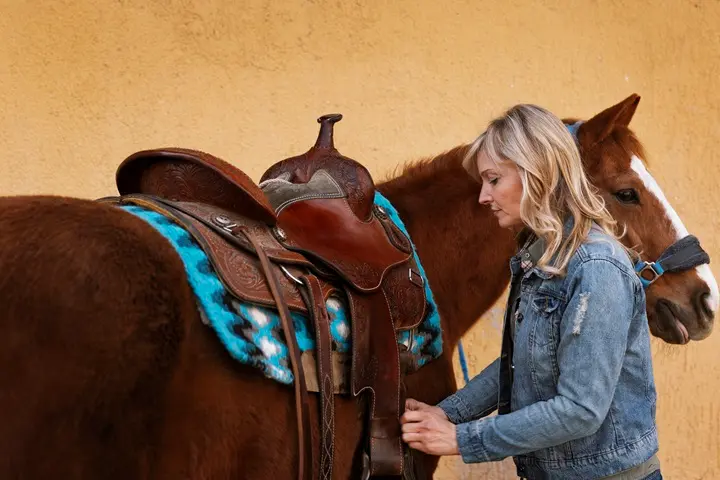A saddle isn’t just a piece of tack. It’s a critical bridge between horse and rider. A properly fitted horse saddle ensures both comfort and communication, enabling safe, effective riding while protecting the horse’s back and the rider’s posture. But just as horses vary dramatically in size, so too must their saddles. Choosing the right pony horse saddle or full-sized saddle requires an understanding of anatomy, discipline, and design.
Saddling Up the Smallest Equines

Ponies may be small, but they’re far from miniature horses. Their compact builds come with unique challenges when it comes to saddle fitting. A pony’s back is typically shorter, flatter, and rounder than a full-sized horse’s, which means standard saddles just won’t work.
One key difference is the pony’s shorter saddle-bearing area. Saddles with long panels can extend too far back, putting pressure on the loins and causing discomfort. At the same time, many ponies have wider, barrel-like bodies that require flatter or wider tree shapes. Trying to squeeze a narrow tree onto a wide-backed pony will pinch and restrict movement.
Additionally, well-fitting pony horse saddles are often paired with smaller riders, usually children. This introduces a new set of needs. Saddles must help promote balance, security, and confidence. Features like deeper seats, grab handles on the pommel, and extra knee blocks can support young riders as they develop their skills.
There are several types of pony saddles available to suit various disciplines. Pony all-purpose saddles are versatile, and suitable for light jumping, flatwork, and trail riding. Pony dressage saddles are designed with a straighter flap and deeper seat to encourage proper rider position. For young jumpers, pony jumping saddles offer forward-cut flaps and supportive knee rolls. Western riders aren’t left out either. Western pony saddles mimic the traditional look and feel but in a scaled-down size for pony comfort and control.
Proper sizing of a pony saddle is essential. It’s not enough to fit the pony. You should also consider the rider’s size and leg length. Professional fitting is strongly recommended to ensure the child and pony are comfortable and safe.
Bridging the Gap
Between ponies and full-sized horses, there’s a group that often gets overlooked: small horses and cobs. These equines can be tricky to fit because they’re too large for pony saddles yet may not suit a standard horse saddle either. Cobs typically have shorter backs and broader builds, with low withers and rounded ribs. This makes fitting standard saddles challenging, as they may bridge or slide around. That’s where cob saddles come in. These saddles are specifically designed with wider trees and shorter panels to better match the unique proportions of cobs and smaller horses.
Discipline still plays a key role in selecting the right saddle. A cob used for dressage may require a model with deeper seats and larger blocks for rider support, while a jumping cob will need a more forward-cut flap and a tighter fit for precision. Trail or endurance riders might opt for lightweight saddles that prioritise comfort over technical performance.
Fitting the Full-Sized Athlete
When it comes to full-sized horses, riders have a wide range of horse saddles to choose from, depending on discipline, conformation, and personal preference.
English saddles come in several styles:
- All-purpose saddles are good for general riding and beginners.
- Dressage saddles have deep seats and long, straight flaps.
- Jumping saddles feature forward-cut flaps for jumping positions.
- Eventing saddles balance features of jumping and dressage.
- Endurance and racing saddles are built for lightness and long hours in the saddle.
Western saddles include:
- Trail saddles are made for long rides with comfort in mind.
- Ranch and reining saddles, built for functionality and control.
- Barrel racing saddles, designed for speed and tight turns.
- Pleasure saddles, for casual riding and showing.
No matter the style, proper fit comes down to a few key points. The tree's size and shape must match the horse’s wither and back profile. The panels need to distribute weight evenly without causing pressure points. For the rider, the seat size should allow a balanced position with enough space to move freely without sliding.
The Power and Presence

Stallions are often similar in size to mares and geldings, so many of the same saddle types and fitting principles apply. However, their muscling and temperament can bring unique challenges. Some stallions have more pronounced musculature, especially along the shoulders and back, which can require careful consideration when selecting a saddle tree and panel shape. A saddle that fits a gelding of similar size may still cause pressure points or restrict a stallion’s range of motion.
Their expressive movement and strength can also put saddles to the test. It’s vital to ensure the horse saddle remains stable during energetic gaits, sharp turns, or sudden bursts of power. Regardless of discipline, a professional saddle fitting is highly recommended for stallions. Their value and sensitivity mean getting it wrong isn’t an option.
Beyond Size
Size and fit aren’t the only factors that matter when choosing a saddle. Rider experience, budget, and material choice can all influence your decision. For novice riders, saddles that offer extra support can build confidence and correct posture. Advanced riders may prefer more minimal designs that allow for a closer connection and greater freedom. When it comes to cost, there’s a wide range. While premium horse saddles can be a significant investment, affordable options still provide solid comfort and durability for casual riders.
Leather saddles are traditional, durable, and elegant but require regular care. Synthetic saddles are lightweight, easier to clean, and often more budget-friendly, though they may not offer the same lifespan. Maintenance should never be overlooked. Whatever saddle you choose, proper storage, cleaning, and periodic checks for wear and fit can extend its life and keep your horse happy.